Seven researchers are propelling MTSU to new heights
By Allison Gorman
Gender equality as a social and economic issue has been amplified steadily through recent decades and rightfully so. Updated statistics about career disparities between women and men in terms of participation in leadership, advancement and recognition, and compensation are regularly reported by media outlets. Although significant changes in policy and culture during the past 50 years, particularly in the U.S., are reducing barriers to equal representation, the causes of gender disparities can be complex and remain entrenched in many areas. The consequences of gender inequality in the workforce also extend beyond the lack of fair treatment of individuals and groups regarding access to opportunity. When groups of people are categorically excluded from participation on the basis of their identity, society also suffers lost opportunity — the opportunity to benefit from the contributions which those excluded members of society could make.
Higher education is not immune to gender disparities among faculty and other scholars either. A greater proportion of high-ranking, full professors tend to be men than women, while the inverse is observed for lower-ranked assistant faculty, according to U.S. Department of Education statistics maintained since 1960. The same data also map a persistent national trend of salaries averaging around 10 percent less for female faculty than their male colleagues. Men account for more higher-status outcomes than women in many other metrics of success and status among university scholars as well, such as publication rates, numerous scholarly studies show. The genders also are disproportionately represented across faculty ranks in many disciplines, with women especially under-represented significantly in science, technology, engineering, and math — aka STEM — fields.
MTSU researchers earned a grant in 2014 from the National Science Foundation to study the recruitment, retention, and promotion of women STEM faculty. The aim was to develop a clear understanding about the climate for women STEM faculty on our campus. The percentage of female faculty at MTSU rose from 39 percent to 48 percent between 2000 and 2016, and while women still hold a lower number of tenured positions at MTSU, that gap has slowly been closing. This MTSU study and many others document an array of barriers and challenges to women’s advancement in scholarly careers and offer recommendations to eliminate these obstacles. Unfortunately, persistent stumbling blocks include simple male bias and societal expectations about “normal” career paths for women — both of which can be blind to a woman’s potential to master and contribute to a field.
One countermeasure to such barriers is to recognize the success of women in academic scholarship, innovation, and service. To that end, this issue of MTSU Research spotlights seven remarkable scholars at MTSU who are leaders in their respective fields and who are women. Their stories are featured to both celebrate these individuals’ hard work and success and to present models of women’s outstanding accomplishments in research.
PIPPA HOLLOWAY
PROFESSOR OF HISTORY AND FACULTY SENATE PRESIDENT
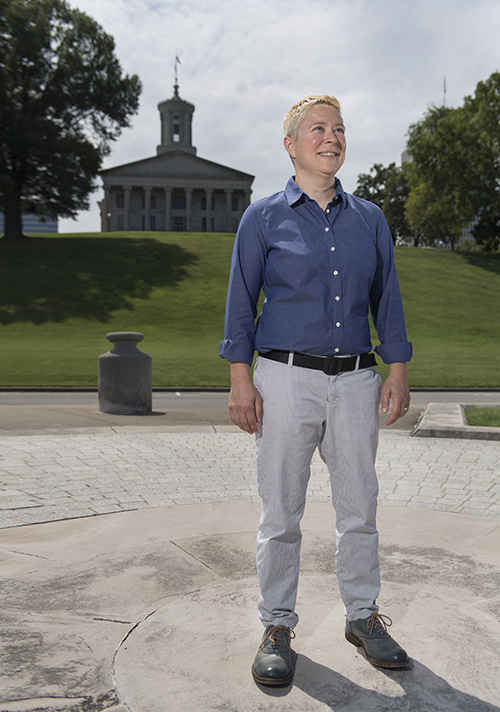
Usually the researcher chooses the research. Sometimes it’s the other way around.
Pippa Holloway had her academic life all mapped out when she earned her Ph.D. in 1999. She would specialize in lesbian, gay, bisexual and transgender, or LGBT, history, having studied under a pioneer in the field, John D’Emilio, and written a book about the politics of sexuality.
Then in 2004, when she was volunteering with a voter registration drive at a Nashville housing project, Holloway noticed that a large number of the residents she met had prior felony convictions. “Many were unaware that they couldn’t vote because of that, or they were confused about the law,” she recalled. “As a fairly dedicated voter registrar, I tried to read the law so I could explain it to people. It was incredibly complicated.”
Holloway, now an MTSU professor of history, has spent much of her academic life since then unraveling the relationship between voting rights and our legal and penal systems, and documenting their combined effect on minority voters.
Her early interest in the subject might seem prescient now that voting rights are such a hot-button issue, but Holloway says she simply recognized a historical pattern.
“One thing you know as a historian is that when laws are really complicated, they are often unfairly or unevenly enforced,” she said. “I suspected there were historical reasons for the complexity of Tennessee law, and I wanted to compare Tennessee’s law and felon voting practices in other states. That led me to the book.”
Living in Infamy: Felon Disfranchisement and the History of American Citizenship, published in late 2013, describes how white southern Democrats in the Jim Crow era limited African-American political power by tying voting to criminal history.
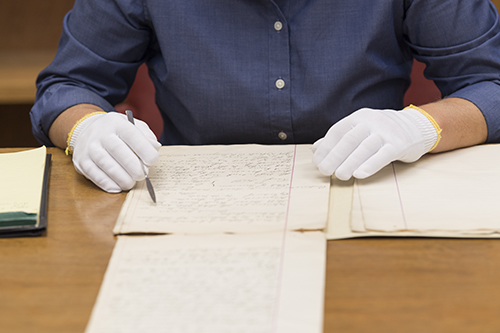
The parallel trends of draconian prison sentences and high-visibility punishments, like forced labor, fed the public perception that felons couldn’t be rehabilitated and shouldn’t be allowed to vote.
While the Voting Rights Act of 1965 eliminated poll taxes and literacy tests, Holloway writes, it did not prevent majority-party lawmakers in the South from limiting voting through felon disfranchisement. Even today, in four Southern states including Tennessee, one in five African-Americans cannot vote due to a felony conviction, she says.
And the ripple effect of disfranchisement has spread far beyond the South.
During that voter registration drive in 2004, Holloway was keenly aware of the fact that the previous presidential election had been decided by the slimmest of margins in Florida, which had just rigorously purged its voter rolls. “My guess was that the playbook of 2000, which was based on voter suppression, would be utilized again because it had been so successful,” she said.
As that political playbook gains traction nationally, so does Holloway’s expertise on the subject. Her research has been cited in court cases in Alabama, Florida, Louisiana, and Iowa.
“One of the ways I wanted my research to matter is in voting rights litigation,” she said. “It is fully doing that.”
Holloway has become a sought-after speaker at universities and legal symposia, although her favorite audience is the community she writes about. She says she was excited to speak to inmates at the Indiana Prison for Women and to see Living in Infamy reviewed in Prison Legal News, written by and for prisoners acting as their own attorneys.
“I’ve learned from my connections in the world of legal justice that some of the finest legal minds in America are incarcerated,” Holloway said.
She’s also working on a third book, about limitations on the ability to testify in court, including restrictions due to felony convictions. Two years in, she’s still determining its parameters. “I’m looking at all 50 states, pretty much from the colonial era to, I don’t know, somewhere in the 20th century,” Holloway said. “I think it’s good to push yourself as a scholar.” At this point, she jokingly refers to LGBT history as her “side hustle.”
Maybe that will be book four.
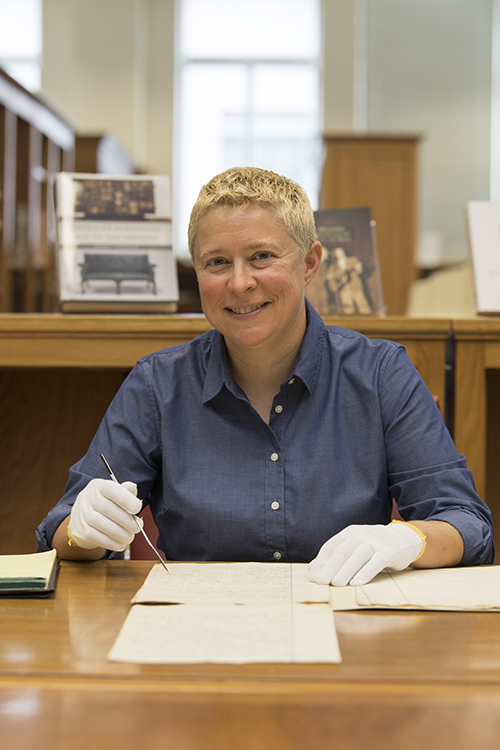
Holloway has lots of professional role models. In fact, she’s related to several of them. Her parents, stepmother, and brothers all earned doctorates and established themselves in what she calls “the family business” — academia.
But it was the example set by her late mother, renowned biomedical researcher Caroline Tobia Holloway, that encouraged her to pursue a career in which she would be a minority on two counts. Political and legal history is still a male-dominated field, Holloway notes, and the teaching profession has traditionally excluded openly gay people.
“My mom fought a lot of battles as a woman trying to be a scientist in the 1960s,” Holloway said. “That gave me the confidence and inspiration to do what I wanted to do.”
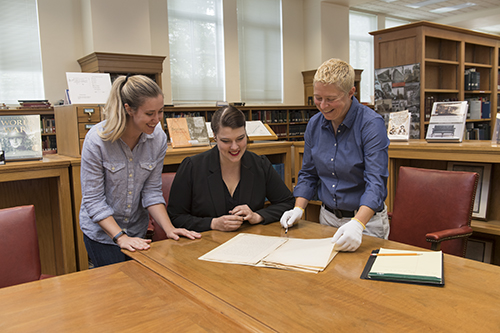
Casey Gymrek, alumna and education specialist, left; Lindsay Hager, alumna and librarian; and Dr. Pippa Holloway, history faculty member, at the Tennessee State Library and Archives.
SANDY STEVENS
ASSISTANT PROFESSOR OF EXERCISE SCIENCE
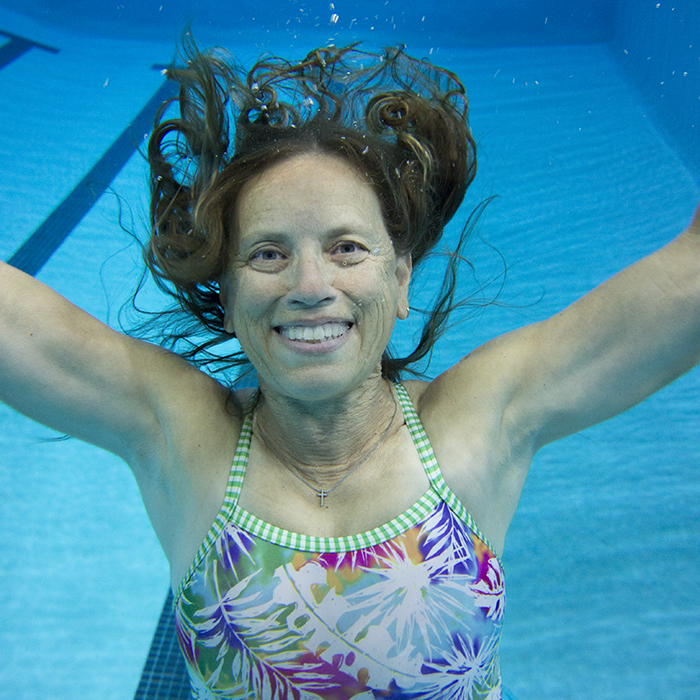
Sandy Stevens gives people their lives back, one step at a time. She also gives them hope — something they’ve often lost before they hear about the amazing things that happen in the underwater treadmill lab at MTSU.
Participants in Stevens’ research come to her in wheelchairs, paralyzed by spinal cord injuries and having completed the prescribed medical treatment and physical therapy. Many have been told that they’ll probably never walk unassisted again.
But with training, they routinely defy that prognosis.
Stevens, an assistant professor of exercise science, spends much of her time in a bathing suit, armpit-deep in a tank of water behind a research participant, propelling that person’s feet forward with hers on a treadmill. It usually isn’t long before participants are taking those underwater steps by themselves. Most of them go on to take independent steps on dry land, too.
Those remarkable outcomes reflect what seriously injured people can do given safe, ongoing opportunities to improve even after their conventional therapeutic options — and usually their insurance — are exhausted, Stevens says.
“The evidence is pretty consistent that if you allow someone to be chronically exposed to activity, their body adapts, regardless of the level of injury or impairment. To whatever extent they have the capacity to improve, they will. But nobody is going to get stronger if they sit in a wheelchair all day,” Stevens said.
For people suffering from chronically painful conditions like arthritis or recovering from orthopedic injury, the treadmill is a conventional rehabilitative tool. But for people who can’t walk because of permanent neurological damage, treadmill therapy has always seemed inherently unsuitable.
Stevens and her research team have turned that logic on its head.
“The base idea is that if you’re paralyzed, the treadmill isn’t appropriate for you, and I think that’s where the line is drawn in a lot of facilities,” she said. “What we’re doing different here is saying, ‘Those are the people who need it most.’ And as far as I know, we’re the only place conducting research on underwater treadmill training.”
Stevens’ work has put MTSU on the map for therapeutic research. Paralyzed people have traveled from places such as Chicago and Atlanta to participate in her studies, and the lab has had significant success winning competitive grant funding. The lab is highly collaborative, with both students and other key staff contributing to the success the lab has experienced.
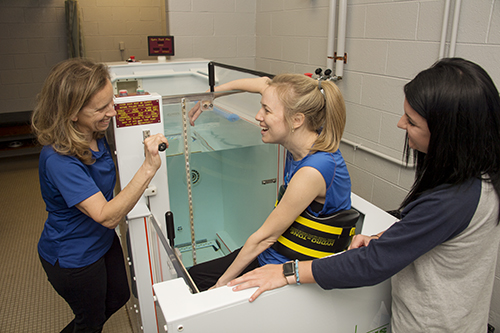
Sandy Stevens with Lindy Cunningham
The National Institutes of Health, which typically favors research in medical settings, has funded two treadmill studies at MTSU. The first involved children with cerebral palsy; the second, now wrapping up, involves people with incomplete spinal cord injuries — that is, some sensory or motor function remaining.
Participants in that second study receive about four months of therapy, just enough time to make tantalizing progress, Stevens says. So she initiated a separate project to extend their therapy for two more years, to see just how far it can take them. She is also coordinating a study working with people with complete spinal cord injuries. Even those participants, who come to the lab totally paralyzed, typically end up taking steps on their own.
Every one of Stevens’ 50 participants so far has regained some ability to walk independently.
She’s convinced that their success is about the treadmill as much as it is about restoring people’s hope that they can walk again, and giving them an opportunity to try.
“We have people who make incredible progress in the first two or three days,” she says. “That can’t be a training effect. … I think it’s just that somebody’s walking the journey with them.”
Stevens can sympathize with their struggle. She still recalls her own feelings of hopelessness 17 years ago, following a bus accident in a remote part of Africa that left her with injuries of her own. She rarely discusses the experience, however, saying it doesn’t compare to what her research participants deal with every day.
Stevens has walked her journey and now she’s walking theirs too, one step at a time.
 After years of rehabilitative experience, Sandy Stevens just couldn’t accept the idea that a good wheelchair and adaptive strategies were all she could offer people with neurological impairments.
After years of rehabilitative experience, Sandy Stevens just couldn’t accept the idea that a good wheelchair and adaptive strategies were all she could offer people with neurological impairments.
“A sedentary lifestyle is related to fairly severe health consequences,” she said. “When you’re working at a clinic, even when you feel you’re doing the best job you can, leaving people without the capability to be as healthy and fit as possible seems like you’re missing part of the picture.“
Hoping to advise paralyzed people on how to increase their fitness through exercise, Stevens looked for evidence-based studies on the subject. “There just wasn’t anything there,” she said. “So I thought, ‘Well, if we want to change this, I’d better go create some evidence.’”
That’s how great research is born.
LYNN BOYD
PROFESSOR OF BIOLOGY AND CHAIR OF THE BIOLOGY DEPARTMENT
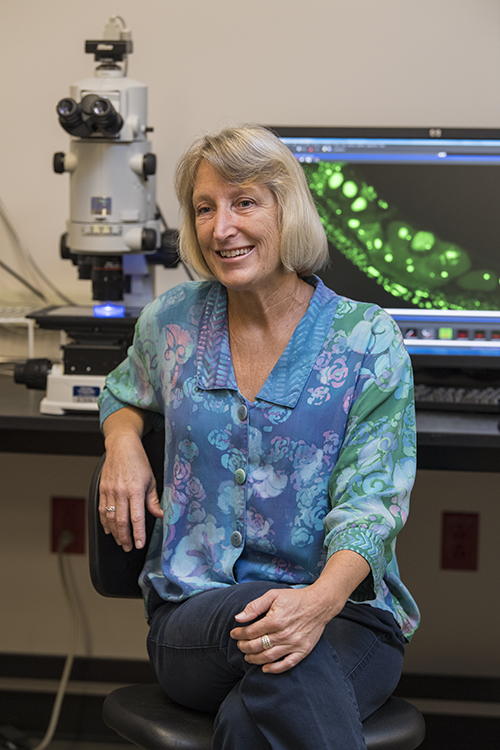
If you think working in a worm lab sounds boring, Lynn Boyd will set you straight.
She started her post-doctoral research in a worm lab at Cornell University. Twenty-five years later, as chair of the MTSU Department of Biology, Boyd still waxes rhapsodic about the small nematode that’s the perennial subject of her research.
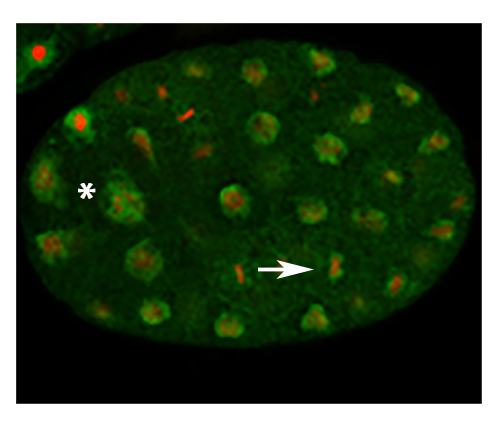 Caenorhabditis elegans has a set of qualities no other lab animal shares. It’s quick and easy to grow, and it’s entirely transparent. So by using fluorescent dyes and other special tools designed for “working in the worm” (there are lots of enthusiasts out there), Boyd can experiment on Caenorhabditis elegans and observe the internal effects in real time — while it’s alive. And if it does happen to succumb … well, it’s a worm.
Caenorhabditis elegans has a set of qualities no other lab animal shares. It’s quick and easy to grow, and it’s entirely transparent. So by using fluorescent dyes and other special tools designed for “working in the worm” (there are lots of enthusiasts out there), Boyd can experiment on Caenorhabditis elegans and observe the internal effects in real time — while it’s alive. And if it does happen to succumb … well, it’s a worm.
“There are all these studies showing that if we treat animals a certain way, we get a certain outcome,” she said. “But what’s cool about this is that we’re able to see what’s happening inside the individual cell.”
The cell’s inner workings have always fascinated Boyd, who says that as a researcher, she’s driven more by intellectual curiosity than by the application of whatever she learns. For her, working in the worm is its own reward, but two of her discoveries in particular could pay big rewards in the fields of genetics and reproductive medicine.
Both those discoveries have to do with ubiquitin, a small protein found in almost all organisms. By watching the behavior of ubiquitin inside the worm, Boyd helped solve a genetic mystery: why we inherit mitochondria from our mothers but not our fathers.
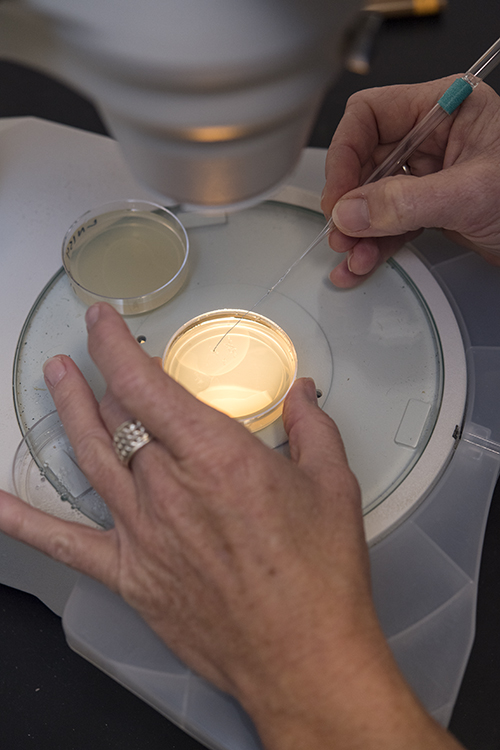
That rule doesn’t just pertain to humans; it’s true of anything that sexually reproduces, including Caenorhabditis elegans. While both sperm and oocyte contain mitochondria, known to schoolchildren everywhere as “the powerhouse of the cell,” only the mother’s mitochondria are passed along to the offspring. “It wasn’t clear what was happening to the mitochondria from dad,” Boyd said.
Partnering with a French lab, Boyd’s research team showed what’s happening to it: Ubiquitin “tags” it for destruction by the cell.
Now one of Boyd’s graduate students at MTSU has found a way to preserve paternal mitochondria during reproduction, and so the team is launching new research to explore a huge question: What happens if we keep our fathers’ mitochondria?
That project feels more like a beginning than an end, but for another of Boyd’s ubiquitin projects, the opposite is true. More precisely, it might be the beginning of the end of stress-related fertility problems — another biological phenomenon that’s long been recognized but not understood.
 Fluorescent Caenorhabditis elegans gave Boyd and her team a perfect view of the immediate effects of stress on an oocyte.
Fluorescent Caenorhabditis elegans gave Boyd and her team a perfect view of the immediate effects of stress on an oocyte.
Using various means — high salt, starvation, ethanol exposure — they stressed adult worms and then watched the cellular reaction. Their curiosity was rewarded: Ubiquitin in the oocyte shifted to its nucleus and began producing tiny bodies that Boyd calls “stress-induced nuclear granules,” or SINGs.
“This was a novel discovery,” she said. “Although it’s known from human and mammalian studies that stress on the adult will affect reproductive capability — people who are exposed to oxidative stress have lower fertility, that sort of thing — we show the stress response at the cellular level. This opens up a whole other research pathway: What are SINGs? Are they helpful? Are they harmful?”
Boyd suspects this phenomenon is common to cells throughout the body; she’s seen it in the intestines and muscles too. While the implications for medical science, and certainly for follow-up research, are vast, she plans to continue on the reproductive path. Her goal is to identify and remove the genes involved in the ubiquitin stress response, then study the impact on fertility.
Between that and the mitochondrial project, Boyd said “there’s enough to keep me going till the end of my career.”
Just one more reason to love working in the worm.
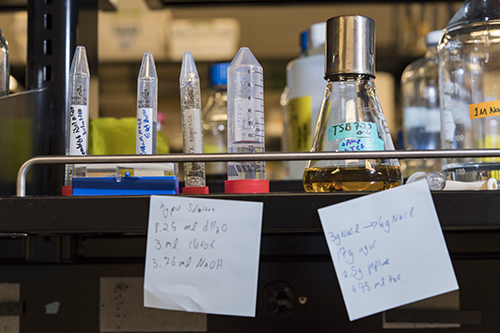
In biology, women are ubiquitous. “There’s no shortage of women in the field, and so I never felt out of place,” said Boyd, chair of MTSU’s biology department.
Discovering that field might have been her biggest professional challenge. With a bachelor’s degree in Latin, Boyd was flipping through the University of Utah catalog — ostensibly looking at medical school information, though she didn’t want to be a doctor — and stopped on the page devoted to the Human Genetics Department. “I ended up applying, and I went to classes and met all these scientists, and I thought, ‘This is where I need to be.’ It was obvious to me.”
As a professor, Boyd says her enthusiasm for biology has never waned — and she hopes it’s contagious.
MARY FARONE
PROFESSOR OF BIOLOGY
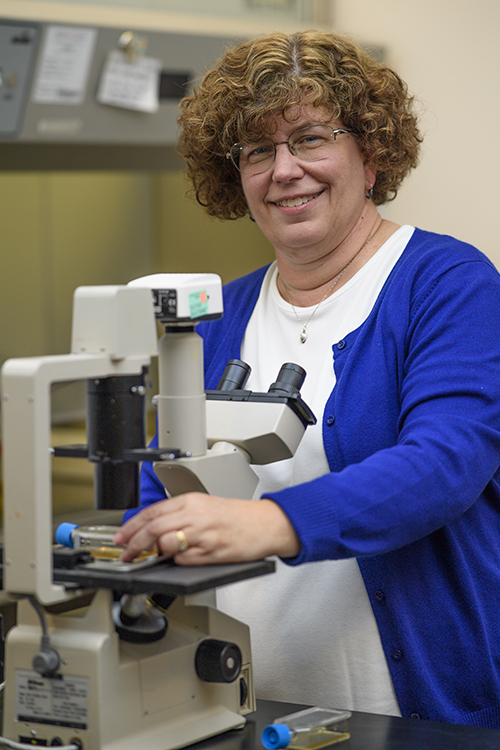
The first thing Mary Farone teaches graduate students who work in her lab is that patience is a virtue. Pure science is a team sport, and everyone is playing the long game.
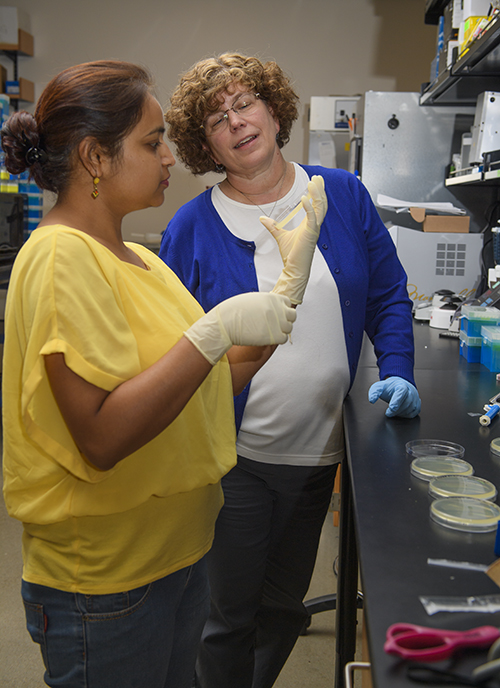
Dr. Mary Farone, MTSU Biology professor, and Shrijana Bhattarai, PhD candidate in molecular bioscience, in the lab.
“When they come into the lab, they all want to do Nobel Prize work,” said Farone, a professor of biology at MTSU. “That is a wonderful goal, but I try to stress that there are many things that go into an overall project, and that no one person is going to be able to do all of them. Science is very cooperative, whether it’s in our laboratory or with other institutions.”
For researchers like Farone, the big payoff can be decades in the making. She still derives satisfaction from one of her graduate research projects at Miami University in the early 1990s, which led to another lab developing a cancer therapy agent.
But there are smaller, more frequent payoffs in the promise of research. Such is the case with Farone’s recent discovery of two new bacteria, which could one day shed light on unexplained respiratory illness and even lead to new ways to treat disease.
The key to work like Farone’s is not taking your eye off the ball, no matter its trajectory.
In her case, the ball was a powerful type of bacteria known to infiltrate municipal water by hiding inside disinfectant-resistant amoebas. That’s how the bacteria got inside a hotel’s chiller plant in 1976, killing 29 people and sickening 153 at an American Legion convention in Philadelphia.
More than 20 years after that first outbreak of the respiratory illness now known as Legionnaire’s disease, Farone’s MTSU research team and a team from Tennessee Technological University began studying Legionella pneomophia with a grant from the Environmental Protection Agency. Their mission was to assess the prevalence of Legionella-like bacteria in water from human-made and natural environments. After collecting amoeba-filled water from sources in Tennessee, Texas, and New Jersey, the team examined the samples for evidence of bacteria. Then they froze the infected samples until the bacteria could be identified.
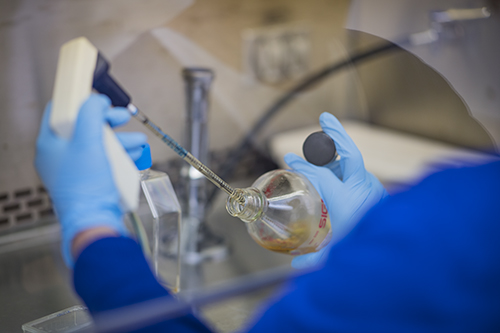
By 2003, they knew they didn’t have Legionella pneomophia, and they began using DNA sequencing to try to identify the bacteria in their samples. By 2016, they published manuscripts describing two previously unknown bacteria, originating from a hot tub and a cooling tower in Putnam County, Tennessee.
Farone named them Candidatus Berkiella aquae and Candidatus Berkiella cookevillensis after Sharon Berk, her former mentor and colleague from Tennessee Technological University in Cookeville and now her consultant on another project.
These new bacteria have characteristics of Legionella but also two notable idiosyncrasies. First, unlike most bacteria, they seem to enter the nucleus of a cell in an organized way rather than by happenstance. Then they quickly replicate, destroying the host cells.
Second, the bacteria grow only inside other cells, the way viruses do. That has made culturing them in the lab a challenge, Farone said: “We can make more of them, but our ability to study what makes them work is limited because we can’t grow them on normal laboratory media.”
At this point Farone has more questions than answers, but even the questions hint at medical promise.
She wants to learn exactly how these bacteria enter the nucleus in such a deliberate manner; perhaps they could be used therapeutically, to target cancer cells. “These bacteria have very large genomes —they carry a lot of DNA,” she added, “so they have great potential for genetic manipulation.”
Farone also wants to know whether these bacteria, which grow like viruses and behave like Legionella, are in fact pathogens. Perhaps they could explain some of the 70 percent of pneumonia cases with no known cause.
There is plenty of research yet to be done; in a sense, it’s just beginning. Those water samples, collected back in 1999, are revealing new information every day, thanks to steady advances in research technology and the steady patience of Farone.
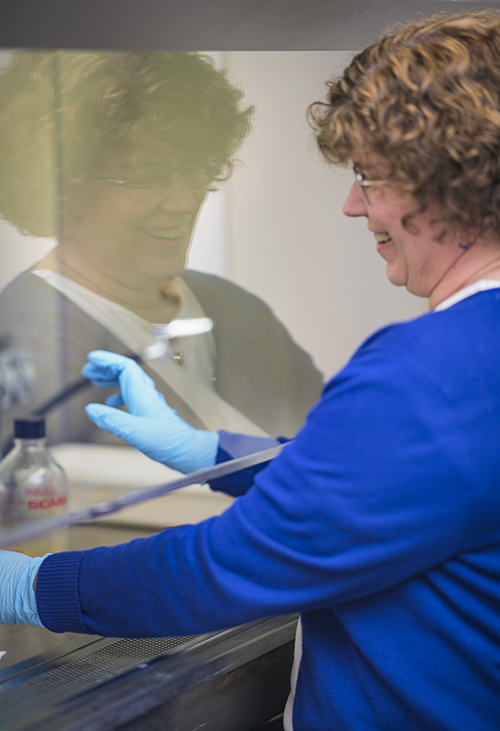
It was a physics teacher at Farone’s all-girls high school who inspired her to become a scientist. Of course, neither one realized that at the time.
“Sister Mary Ethel came up to me and said, ‘Next year I want you to join Science Club.’ And I was like, ‘What? Why me?’” Farone recalled.
The rest is history. And biology.
Farone still keeps in touch with Sister Mary Ethel, who once recognized something in her that she didn’t recognize in herself.
“I always think about her when I talk to students who are struggling, or who might be interested in something but are afraid to ask,” Farone said. “She saw potential in me, and I always like to see potential in them.”
NORMA DUNLAP
PROFESSOR OF CHEMISTRY
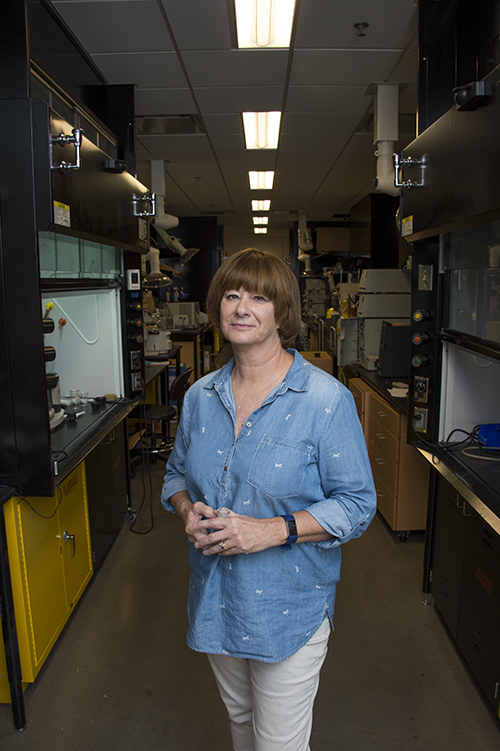
When Norma Dunlap left her job as a medicinal chemist for Hoffmann-La Roche in New Jersey to teach chemistry part time at Vanderbilt University in Nashville, her former co-workers thought she was nuts. In the 1980s, the pharmaceutical industry was the place to be.
Dunlap couldn’t argue that point: She loved her interesting, lucrative job. She’d also never taught before. But after some careful calculations, she went with what seemed like the right course of action. Her husband, also a chemist, had been offered a coveted professorship at Vanderbilt, and in Tennessee they could afford a house even if Dunlap was “making next to nothing” lecturing twice a week and raising their young child.
At Vanderbilt, Dunlap discovered that she enjoyed teaching, and having two more children made her appreciate the job even more. When her three kids reached school age, she accepted a full-time position in MTSU’s Department of Chemistry, where she is now a professor.
Meanwhile, the pharmaceutical landscape was shifting. Once-safe careers were lost to chronic mergers and downsizing. About 10 years after Dunlap left the American headquarters of Hoffman-La Roche, the 5,000-person plant in New Jersey began bleeding jobs, and eventually it closed down altogether and shifted its headquarters to California.
What wasn’t clear to her then, she says, is abundantly so now: Leaving industry for academia was the right move. In life, as in the lab, it can be years before you know whether your careful calculations will end in success.
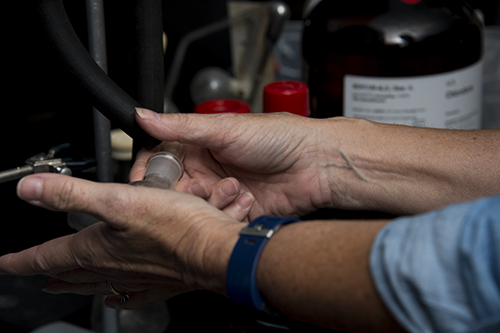
For a medicinal chemist, success is a process. It means designing a compound to act a certain way; taking it through multiple steps of synthesis, usually of the two-steps-ahead, one-step-back variety; and, finally, having tests prove that it does what it was designed to do biologically.
Dunlap and her research students are in various stages of that process with a large, multifaceted project: designing a core molecular structure that can be synthesized in four steps and then changed in different ways to target specific enzymes linked to disease. She says initial assays have been promising for compounds designed to inhibit the proteasome, linked to certain cancers. Other compounds formulated to impede beta-secretase, linked to Alzheimer’s, also have shown some promise in initial assays.
The goal isn’t to get a new medicine to market, which can be a billion-dollar proposition, but to create a compound that could lead to the active ingredient in someone else’s new medicine, Dunlap says. “We might be able to get something to the point that we can say, ‘Yes, it has activity in a mouse,’ and get a drug company interested in licensing and developing it.”
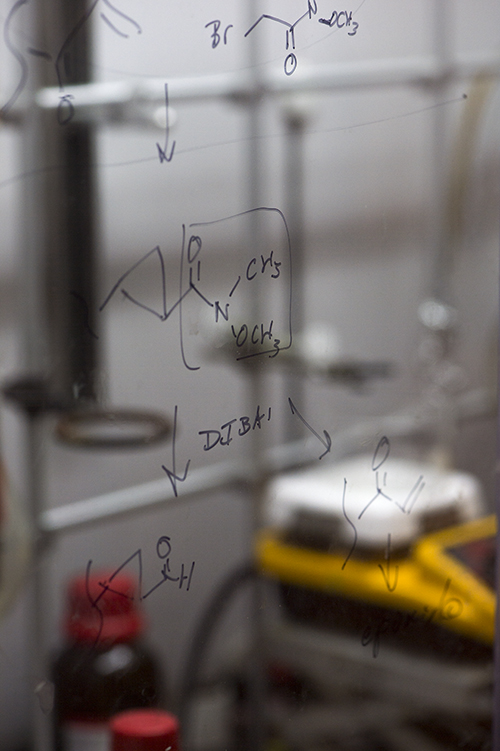
Even if they never see its final application, Dunlap’s senior-level Medicinal Chemistry students get excited about the life-changing potential of science. Each student must present on promising research that’s still years from marketability, and “they really respond to that,” she said.
But students in lower-level chemistry classes often need a hook to draw them in.
“Especially coming out of high school, they think science is just a bunch of facts that they have to memorize,” Dunlap said. “They don’t get any feel for how exciting it is, how relevant to their lives.”
To that end, she’ll tuck a chemistry lesson into the context of a drug advertised online and on TV.
Pharmaceutical companies weren’t always allowed to pitch directly to consumers; that change, too, was in the works when Dunlap left industry for academia. And while direct-to-consumer advertising of pharmaceuticals has been roundly criticized, it has had a good side effect on Dunlap’s teaching: It helps her meet today’s college students where they live — on screen.
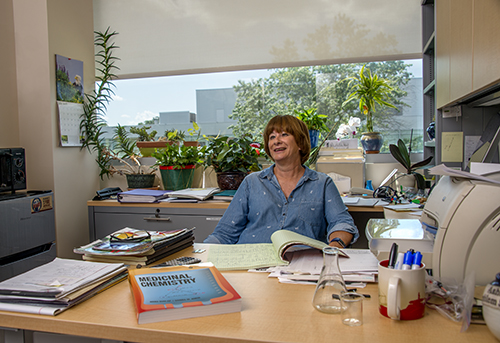
Dunlap still laughs recalling her first job interview as a chemist: “The guy asked me if I knew how to change a tire — because how would I get to work if I had a flat? And he asked me if I knew what a Phillips-head screwdriver was.”
Dunlap, who answered yes to both questions, got the job, becoming the only woman in the Philadelphia-area chemical plant, save a couple of secretaries.
“That was a learning curve,” she said, “though 90 percent of the guys were very nice.” Still, there were episodes of sexual harassment — perhaps attributable to a rougher-than-usual workforce at the plant, which received government compensation for hiring ex-cons.
Dunlap has never been put off by working in an almost all-male environment, although she sees how other women might be. “Maybe just being from Philly, I’m not easily intimidated,” she said.
That was the ’70s and ’80s, a different era in industry — and chemistry. As a college student, Dunlap was the only woman in her organic class. Now, as she teaches Organic Chemistry, women often comprise more than half the class. Dunlap believes she’s seeing a new trend that needs correcting: That in the worthy push to get girls interested in science, boys are now being left behind.
DIANE EDMONDSON
ASSOCIATE PROFESSOR OF MARKETING
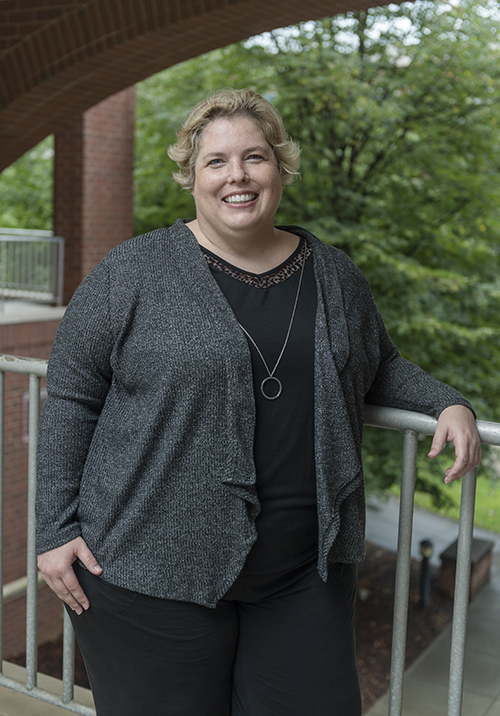
Balancing a career with single parenthood is notoriously difficult, and Diane Edmondson knows that from experience. But she’s also convinced that single parenthood got her where she is today.
Married at 19, then divorced and pregnant at 21, Edmondson was attending college when her baby was born. Undeterred, she finished her bachelor’s degree and went on to earn her master’s and doctorate while raising her young son.
“Without him I probably wouldn’t have pursued a career in academia,” Edmondson said. “I would have said, ‘Okay, I’ve got my MBA, let’s go get a job in industry instead.’ But I could see how the life that I could have in academia would allow me to be there for my son when he needed me.”
In the end it was a win-win-win: good for him, good for her, and good for MTSU.
An associate professor of marketing, Edmondson is a prolific researcher, dividing her focus between applied research and marketing communications and education.
One of her ongoing projects is creating case studies for the classroom, featuring real-world marketing scenarios. She and her students have explored the ethics and dynamics of social media campaigns (the Ice Bucket Challenge); service recovery (a Delta Air Lines computer glitch that stranded thousands of passengers); and nonprofits (the Ronald McDonald House, which is heavily promoted, but meagerly supported, by its namesake restaurants).
Edmondson’s applied research often involves a subtler area of marketing: the employees who play a critical role in the public perception of their organization.
Most of us think of marketing as the space where company meets customer — a cleverly themed sale, for example, or a drugstore end-cap display. But that intersection also has a human face, from cashiers and sales reps to nurses and teachers. These employees, known in marketing research as “boundary spanners,” must serve both company and customer.
“A lot of times that’s antithetical: What the organization wants and what the customer wants are different,” Edmondson explained. “So as a boundary spanner, you’re always thinking, ‘How can I keep both parties happy?’ ”
In other words, boundary spanners face unique and pervasive stress. Edmondson is interested in finding out how organizations can support these employees to help them deal with that stress.
“Research has shown that if you’re unhappy, you’re going to leave your job, and it costs a lot of money to bring in someone new and get them trained,” she said. “So the idea is to figure out ways to get people to stay at their jobs longer and be committed to them.”
Recently, Edmondson began focusing on a new, largely unexplored subject: gender differences among boundary spanners. “I’m looking at how organizational support impacts things like job satisfaction and commitment to the organization, and
whether men and women need different levels of support in order to have better performance and better satisfaction with the organization,” she said.
Her latest study compared four categories of boundary spanners — married men, married women, single men, and single women — to determine which group best handled a stressful job. The winners? Single women, who were less likely to be emotionally affected by stress and who showed more commitment to their job under high-stress conditions.
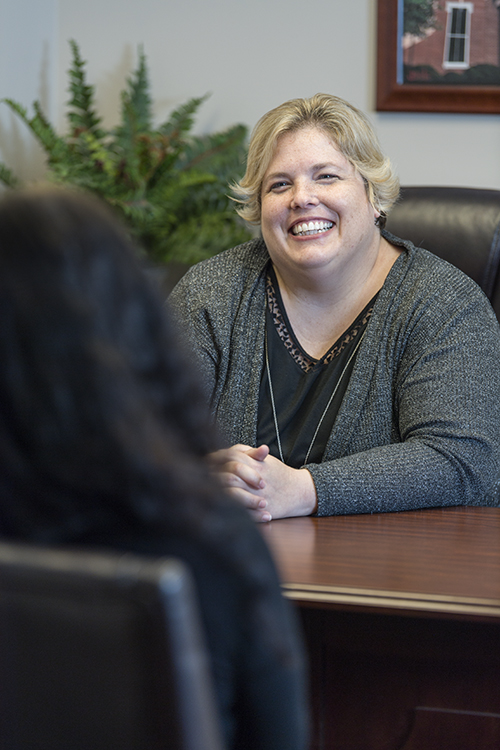
Edmondson found those results surprising at first, until she viewed them through the lens of her own experience. Single women, who so often are their families’ sole breadwinners, might have extra motivation to prove themselves in the workplace and protect their job security.
“I can see how this would happen, being a single woman and a single mom,” she said.
No doubt she can. Edmondson has proven herself professionally with a body of work that extends far beyond her published research, from seats on the editorial boards of two scholarly journals to leadership positions in several professional organizations. Currently, she serves as president of the Society for Marketing Advances, the third-largest marketing conference in academia.
But for all her accomplishments, Edmondson says the most challenging has been balancing her career with single parenthood—perhaps the ultimate exercise in boundary spanning.
Now that her son has just finished high school, Diane Edmondson has had a little more time to take stock of her career so far. She says she wishes she could give this advice to her younger self:
“Don’t take on too many projects, too many obligations. There are times when saying no can actually be beneficial to your long-term success.”
Perhaps her older self will take that counsel. For now Edmondson keeps saying yes — and succeeding.
DEBORAH WAGNON
ASSOCIATE PROFESSOR OF RECORDING INDUSTRY
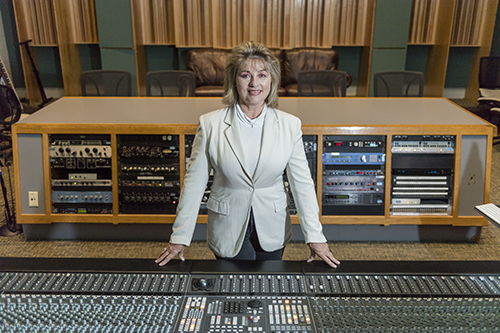
Ask Deborah Wagnon about intellectual property, or IP, rights, and she answers like a woman who just got religion. When songwriters have creative control over their work, she says, “It’s magnificent. You can go crazy with a catalog that you own. All those clichés are really true: Ownership is king. Content is power.”
Power has been a major theme of Wagnon’s professional life. As an attorney in the notoriously male-dominated entertainment industry, she became general counsel of Landmark Entertainment Group in Hollywood. Later she was a partner with an international law firm representing a stable of powerhouse recording artists, including Gloria Estefan, Olivia Newton-John, and Reba McEntire.
Wagnon was lured to that high-flying position from MTSU’s Department of Recording Industry, where she taught in the mid-1990s. When she returned to the university in 2011, a timely change in copyright law gave the associate professor a unique opportunity to keep a personal promise. “I’d committed to myself that whatever I did as a professor had to be based in reality, had to be cutting-edge, and had to challenge students and nudge them to their better selves,” Wagnon said.
That challenge became the Recapture Project, which empowers students and creative artists through academic research.
Until 2011, songwriters or authors who assigned the rights to publishers of their work relinquished legal and creative control over it in exchange for royalties from sales. That left the financial fate of their work in the hands of whoever held the copyright.
But now these artists can terminate a prior copyright assignment to “recapture” a copyright after a 35-year moratorium. With restored creative control of a work, they can give it a fresh shot at profitability, Wagnon said. An old song might be rerecorded by a younger artist, or even reinvented as a Broadway play, as Carole King did with her song “Beautiful.”
Wagnon’s Recapture Project, part of her Copyright Law class curriculum, takes students back into the pop-culture past; in the case of the project’s inaugural year, back to works created in 1978 and their parents’ vinyl. Once they’ve chosen a work they consider particularly marketable, they create a plan to recapture and exploit it. Then they pitch the proposal to the class. Wagnon and two other professors with expertise in copyright law select the winning project, which she presents to representatives of the artist or author.
One of Wagnon’s favorite proposals so far is for Beverly Cleary’s Ramona Quimby, Age 8, which includes a read-aloud app for hospitalized children and a tie-in campaign for St. Jude Children’s Research Hospital in Memphis.
In a sense, all the Recapture Project participants win. “It gives students the confidence to convince a potential client — Eric Clapton or Carole King or whomever — that they know how to get back their copyrights, and to diplomatically propose how to exploit them once they do,” Wagnon said. “Then they can go crazy with the creative side.”
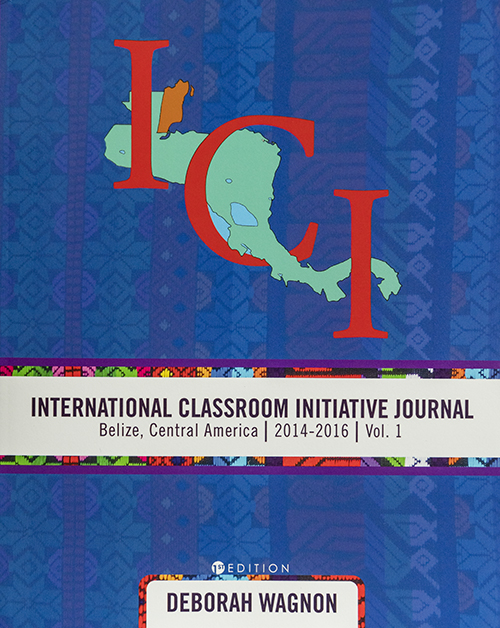
If the Recapture Project immerses students in the nuances of U.S. copyright law, the International Classroom Initiative, or ICI, which Wagnon launched in 2014, drops them into the wobbly infrastructure of IP law in developing countries. So far she has accompanied 44 students to Belize, which Wagnon calls “an amazing cauldron of chaos with respect to IP.” The law is so roundly ignored there that radio stations don’t pay performance royalties.
In Belize, Wagnon’s students witnessed what she preaches about intellectual property as “the fuel that drives our world. . . . It involves trademarks, patents, rights of publicity. Without it, you have no way to claim ownership of what you’ve created and be paid for it—to survive from your talent, rather than just having it as a hobby.”
Her new companion series, The International Classroom Initiative Journal, views IP through the lens of specific “portal territories.” Volume one, ICI Journal: Belize, Central America, includes Wagnon’s own research on Belize and neighboring countries, as well as articles by each student who traveled there through ICI between 2014 and 2016. With subsequent volumes, she plans to broaden the journal’s physical reach and geographical focus, first to all of Central America and then to other continents, highlighting developing markets where strengthened IP law can improve opportunities for creativity and innovation.
As “a loving thorn in the side” of governments that fail to empower their artists, Wagnon has created one more tool with which artists can empower themselves.

When Wagnon attended Georgia Tech, enrollment consisted of only 8 percent female students. She was also a minority at Stanford Law School. Then she entered the entertainment industry, where she was usually the only woman in the room.
But she says trials can be personal turning points, like when she represented Landmark Entertainment Group in a $600 million business deal in Tokyo. The general counsel for another business refused to show up for negotiations until Landmark’s general counsel was there. Of course Wagnon was there — the only woman in the room.
Resisting the urge to have a “Helen Reddy moment,” she instead apologized for the confusion and won him over with her professionalism.
“This was my moment of really understanding the power of experience and wisdom,” Wagnon said.
Researcher features written by Allison Gorman
Read MTSU RESEARCH here: MTSU RESEARCH- Women in Research Vol. 2 No. 1 Spring 2019

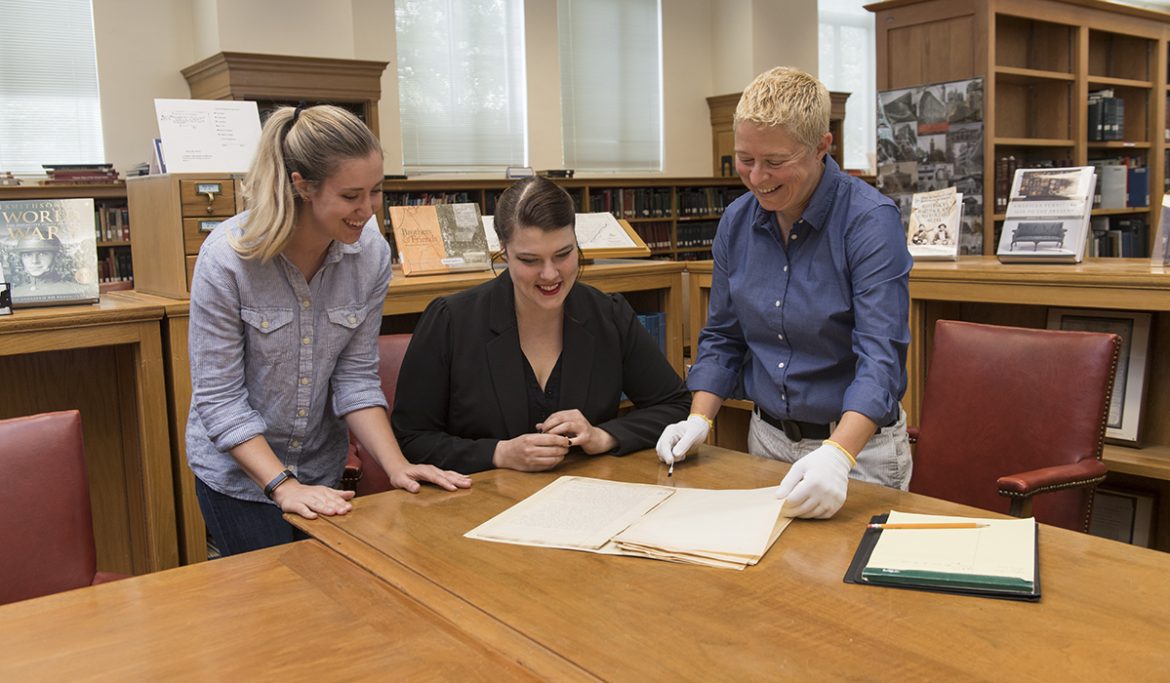
COMMENTS ARE OFF THIS POST